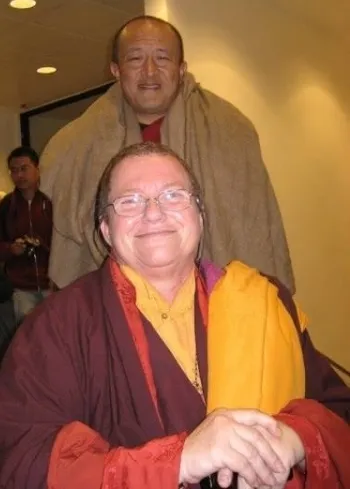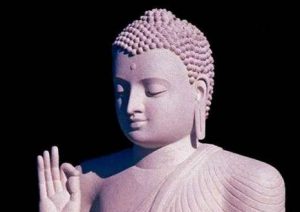Earlier this year, Buddhistdoor published the life story of Ani Zamba Chozom in eight weekly parts.* One of the first Westerners to be ordained as a Buddhist nun, Ani Zamba currently lives in Brazil, where her practical teachings, rooted in the simplicity of Dzogchen, are proving an inspiration to Buddhists and non-Buddhists alike. Here, in three weekly parts,** is a sample of Ani’s teachings, in the form of a conversation.
Frances McDonald: Where is the element of benefiting others in what you teach?
Ani Zamba: Well, listen to your daily life’s speech—everything you think, every view you have about anything, no matter how confused or distorted it is, that’s what you share with everyone around you. “It’s like this, this person’s like that, the situation shouldn’t be like this, it should be like that . . .” Your very limited, confused, distorted way of seeing life is what you naturally share. How can that benefit? It just helps to extend the confusion. Whereas if you have more clarity in your way of seeing and you understand why things appear to you in certain ways, you can explain to others that this is not actually the reality of what’s happening—it only appears to be like that. If we change our attitude towards certain things, then maybe we can see in a more open, compassionate way, a more responsive way. The more you can see clearly, the more there’s a spontaneous response to the needs of others.

FM: As opposed to just reacting all the time.
AZ: Now, “needs” here refers to the basic need of recognizing one’s own nature, which is actually the answer to what we’re looking for. The more you recognize your own nature, the more you recognize that nature in all beings, and you also see what obscures that nature, what prevents other beings from recognizing that nature and being free. You see more and more clearly what is generating their confusion, so then you can communicate with all the different kinds of filters that now condition the way we see things—if you put red lenses in your glasses, for example, the world’s going to appear as red. In daily life, you can communicate because you see precisely the way it is, and you also understand how people get lost in the way they think it is, so you can begin to explain to people on a daily life level that maybe it’s not the way they think it is at all. You’re opening a more flexible attitude to what’s happening in someone’s life. If we look at our perception now, the way we see things is fixed and rigid and solid, and it seems like everything has so much meaning and value from its own side—it’s got nothing to do with us, so to speak. It just is that way.
FM: Do you think this can be a frightening process for some people?
AZ: Of course it’s a frightening process! Look at our basic psychology now. How do we know that we exist in relationship to anything else? That’s not a question we usually ask ourselves. We constantly have to have certain credentials to be able to see things in certain ways. For example, I think I exist—but why do I think I exist? Because I have certain ideas about who I am, how I identify myself. I was born in London in 1948 and I had this kind of education, this kind of parents, and this and this and this, and this has now become my idea of who I am. And then I also give characteristics to everything else I perceive. Oh, that’s a nice table, it might be Chinese . . . I like that vase, it reminds me of something I saw ten years ago . . . we give more and more detail to the phenomenal world, and the more content we give to what we perceive, then it must exist in the sense there must be someone here to perceive it, otherwise how could it possibly exist? The more we make the world solid, then of course the more solid the idea of self becomes.
FM: If something doesn’t really exist, there’s no reference point.
AZ: For people now, the idea is that you build up your world and you make it solid, with your ideas and your value judgments, because it makes you feel solid—if that exists out there, there must be someone here to perceive it, a perceiver. Whilst you have this dualistic fixation between subject and object, then your mind and mental processes regenerate the confusion of not seeing clearly that it’s not that way at all, it’s just how it appears to be because of certain conditions.
FM: Could you expand on why it can be frightening for people to let go of their dualistic fixation?
AZ: As we’ve said, it’s frightening because it’s taking away or dissolving all our reference points. Really, there’s nothing to hold on to, there’s nothing there in the sense of the way it appears to us as being there. You only have good because you have an idea of bad, but bad isn’t an absolute. You can relax—you don’t have to give substance or meaning to anything that’s arising. You can begin to see it as it is, without all the fabrication, all the reification that we’re usually lost in. I think in the beginning, until people get familiar with this, it’s very frightening because you’re just left in space.
*The Life Story of Ani Zamba Chozom: Part One – Journey to India
The Life Story of Ani Zamba Chozom: Part Two – Meeting Lama Yeshe
The Life Story of Ani Zamba Chozom: Part Three – Ordination, First Retreat, and First Teaching
The Life Story of Ani Zamba Chozom: Part Four – Finding the Nyingma Lineage
The Life Story of Ani Zamba Chozom: Part Five – Dzogchen and Meeting Her Teachers
The Life Story of Ani Zamba Chozom: Part Six – Thailand, Burma, and Korea
The Life Story of Ani Zamba Chozom: Part Seven – From Korea to the Philippines to Hong Kong
The Life Story of Ani Zamba Chozom: Part Eight – Brazil
** See A Conversation with Ani Zamba, Part One: Looking at Things in Different Ways











